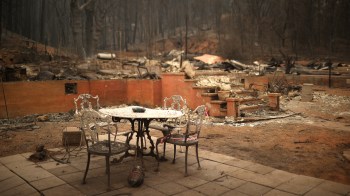
Getting to know what’s in your home

TEXT OF STORY
Tess Vigeland: Eleven tornadoes ripped through Arkansas a week ago, wildfires have already broken out here in Southern California and hurricane season is only a few weeks away. If, god forbid, your house goes up in smoke or underwater in a flood, will you have proof for your insurance company of everything you owned?
It’s called a home inventory and everyone should have one. I invited Candysse Miller to my home to learn what to do. She’s with the Insurance Information Network of California.
Before we even went into the house, she quizzed me about the contents of my living room. So I listed them and we headed for the front door:
Vigeland: Actually, as we’re walking in I’m remembering there’s also a baby grand piano in there.
Candysse Miller: So here you are, you had a test, you forgot that you have a baby grand piano in your living room. Imagine that you’re trying to put together an insurance claim after you’ve lost your home or lost part of your home, the stress of trying to get a new roof over your head combined with trying to remember all of that. The home inventory isn’t just about making sure you have the right amount of insurance, but it’s also your shopping list when you go and rebuild your home.
Vigeland: I’m already seeing that I missed a whole bunch of stuff.
Miller: Well, let’s talk a little bit about what you missed.
AVigeland: nd live in here every day! I completely missed this corner table and the lamp that’s on top of it, all of our fireplace equipment, I missed the mirror on the wall…
Miller: Also think about what sort of home you’re in. You’re in one of these sort of classic Pasadena homes with the lovely… I mean I’m looking at the ceiling merging into the wall. You also have wooden floors in here, so this is a home that’s got very particular details to it and that’s something you probably have talked about with your insurance agent. If you haven’t, you might want to. To have these details replaced, you want to make sure that’s built in to your policy.
Vigeland: OK, so what do I do then? Do I just start writing down every single thing that’s in the room from ceiling to floor?
Miller: What I frankly recommend is taking a little video camera like this, go around the house and actually sort of narrate what you’ve got. If you know the value of it, include that. Create your own little home movie that’s documentary of your home.
Vigeland: So, when we look at putting a value on some of these things like the television, the couch, the glass table that was a hand-me-down from my parents, do I actually need to tell the insurance company, you know, “the couch we bought for X, the TV we bought for X,” because I don’t even know that I still have those receipts?
Miller: Exactly. I get asked all the time “Do I have to keep every receipt for everything I’ve ever bought?” The answer’s no. What you can do, again, as you’re going through if you create the video, just say what you know about it.
Vigeland: All right, let’s go into the kitchen because I have some questions about how detailed you need to get in a place that has all kinds of really small stuff.
Miller: OK.
Vigeland: All right, so here we are in the kitchen with the dog barking outside and there are dishes, there are glasses, there are pots and pans and small appliances and large appliances. How detailed do I need to get?
Vigeland: Well, this is where the video certainly comes in handy. That’s what I recommend. The video camera will let you zero in on, let’s say, all those knives over there — that’s a lot of money just hanging there on your wall.
Vigeland: Right.
Miller: And so if you’ve got a video camera, you can open all your cabinets, all your cupboards, narrate as best you can — “this is the brand, this is…” If you know that detail, it’s going to help you get that much more compensation if you lose it.
Vigeland: All right, well let’s pretend we’ve gone through the whole kitchen. The kitchen is done; thank goodness! Let’s go out in the backyard. I have some questions back there.
Miller: OK.
Vigeland: So here we are in my backyard and my question back here is, you know, obviously the patio furniture we would be able to get an estimate on that, but you know, I have, I think I estimated between 70 and 80 rose bushes, front and back yard. Now that is a lot of money. Is that something that I would ever be reimbursed for? Is that part of a homeowners policy?
Miller: Somewhat. However, there are typically limits on landscape damage, but you want to talk about that with your agent. Is there some sort of endorsement, because typically you’re going to have fairly low limits on landscaping. It’s about rebuilding your house.
Vigeland: Right, right. OK, one last place: you mentioned already the shoes and I wonder if we should take a look at the closet.
Miller: If you’re ready, I am.
Vigeland: Just don’t pay attention to the fact that it’s very messy. So what, would I take a picture of this?
Miller: In a word, yes. You want to know how many shoes you own. Now are you going to hold up every shoe and say “this is a Nike, this is a Payless?” You don’t necessarily have to do that, but you want to have this document because again, if you lost it, how much value do you have inside that closet?
Vigeland: But how do you place a value on any of that in terms of what you’re getting through your insurance company?
Miller: Typically, your closet shouldn’t be the thing that breaks the bank. There are times, unfortunately if there’s a catastrophe, where you may have to start documenting this stuff… literally the point is to get you up to that limit that you have to say “Yes, I met it,” so if you’ve got this sort of documentation, this is one of those pieces that’s really almost more for after the fact.
Vigeland: So it’s not necessarily something that affects your policy beforehand. It’s more to help you as you tell the insurance company “This is what I lost.”
Miller: The closet is about the recovery side of it. Now, what we did in the living room, that’s about making sure you’re properly insured.
Vigeland: So once you’ve got the video and the photos and you’ve written everything down, what do you do with that information?
Miller: Well, a couple things. I really recommend using software like we discussed, because it helps you get organized. It goes room by room and creates that list. What’s most important though is when you’re done with it, get it out of the house. You can put it in cyberspace, lock it down on your personal web site, you can put it in a safe deposit box in a bank, you can send it off to your parents, you know, someone you trust, but get it out of the house.
Vigeland: And is it something that you actually send to the insurance company or is that something that you do afterwards?
Miller: You can do a bit of it up front. You want to talk to your agent and say “OK, let’s talk about my piano,” for example. “Do I need more coverage to make sure that that can be replaced if it’s lost?” But on the back end, if there’s a loss, that’s where the home inventory really helps you recover. It gives you a shopping list for basic things, but also helps make sure that you get all the money that’s coming to you.
Vigeland: Well Candysse Miller, executive director of the Insurance Information Network of California, thank you so much for going through my house today.
Miller: You’re welcome.
Vigeland: Would you like to get out of the closet now?
Miller: You bet!
There’s a lot happening in the world. Through it all, Marketplace is here for you.
You rely on Marketplace to break down the world’s events and tell you how it affects you in a fact-based, approachable way. We rely on your financial support to keep making that possible.
Your donation today powers the independent journalism that you rely on. For just $5/month, you can help sustain Marketplace so we can keep reporting on the things that matter to you.


















